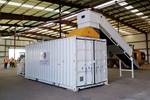Baltic Sea countries sign declaration for additional offshore wind commitment
Eight countries in the Baltic Sea region are to increase current 2.8-GW capacity to 19.6 GW by 2030 and enable cross-border cooperation to facilitate offshore wind expansion.
On Aug. 30, the heads of governments and energy ministers from the eight countries around the Baltic Sea met in Copenhagen, Denmark, committing to new volumes for the build-out of offshore wind in the Baltic Sea and agreeing to cooperate more closely on it and on energy more broadly
The Baltic Sea is said to have high potential for offshore wind, with a current installed capacity of just 2.8 gigawatts (GW). The eight countries have now committed to increase that to 19.6 GW by 2030, as well as consider a 2040 target at a later stage. To reach climate neutrality by 2050, offshore wind in the European Union (EU) needs to grow from 15 GW to 300 GW by 2050. Over the same period, the EU wants onshore wind to grow from 173 GW to 1,000 GW (read “Joint declaration to lead European offshore wind capacity to 150 GW by 2050”).
Germany and Denmark are the only Baltic countries with large-scale wind farms in the Baltic Sea and they are determined to further increase their capacity. The other countries are eager to follow:
- Poland wants to have 6 GW by 2030 and 11 GW by 2040.
- Finland is interested in having its first large-scale wind farm online by 2026-2027, and another one by 2028.
- In Sweden, 15 GW of projects are currently applying for permits. Some could be online before 2030.
- Estonia, Latvia and Lithuania cite interest in commissioning their first offshore wind farms before 2030.
Ultimately, the move toward alternative energy sources is said to be crucial for the Baltic region, as it has been highly dependent on Russian energy imports until recently. Officials recognize that considerations like simplified permitting rules and procedures, a strong European supply chain and investments in offshore grid infrastructure, port facilitates and vessels, are required to speed up the delivery of these wind commitments.
Cross-border cooperation is also of utmost importance. Germany and Denmark have already shown that cross-border offshore wind projects are possible with the Kriegers Flak project, and Denmark has ambitions to connect more of its offshore wind farms in the Baltic Sea to the German grid as well. This will enable the identification of further infrastructure needs to facilitate the expansion of offshore wind, ensure more energy security by improving electricity flows and reduce prices for those countries not well interconnected with the rest of the European grid.
The European wind industry says it will continue to ensure the expansion of offshore and onshore wind goes hand in hand with the protection of biodiversity and in dialogue with local communities and other stakeholders.
Related Content
-
Composites end markets: Energy (2024)
Composites are used widely in oil/gas, wind and other renewable energy applications. Despite market challenges, growth potential and innovation for composites continue.
-
Composites end markets: Batteries and fuel cells (2024)
As the number of battery and fuel cell electric vehicles (EVs) grows, so do the opportunities for composites in battery enclosures and components for fuel cells.
-
Recycling end-of-life composite parts: New methods, markets
From infrastructure solutions to consumer products, Polish recycler Anmet and Netherlands-based researchers are developing new methods for repurposing wind turbine blades and other composite parts.















.jpg;maxWidth=300;quality=90)

